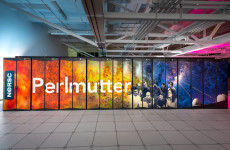Perlmutter Supercomputer Supports Two 2023 Gordon Bell Finalists
November 6, 2023
The Perlmutter supercomputer at the National Energy Research Scientific Computing Center (NERSC) at Berkeley Lab played a key role in two of this year’s Gordon Bell Prize finalist projects.
A group hailing from Harvard’s John A. Paulson School of Engineering and Applied Sciences used NERSC’s Perlmutter system and the researchers’ Allegro software package to produce a nanoseconds-long stable simulation of protein dynamics and an up to 44-million atom structure of an HIV capsid, with strong scaling up to 100 million atoms. The Allegro architecture is intended to bridge the accuracy/speed gap in atomistic simulations and enable the description of dynamics in structures of unprecedented complexity at quantum fidelity. This work, which earned them the Gordon Bell nomination, was designed to demonstrate these capabilities.
“Atomistic simulations can reveal mechanisms inaccessible to experiments and predict behavior based on a first principles quantum mechanical description of atoms and electrons,” said Alby Musaelian, a Ph.D. student in applied mathematics at Harvard whose collaborators on this work include Anders Johansson, Simon Batzner, and Professor Boris Kozinsky in the School of Engineering and Applied Sciences. “The trade-off, however, between computational efficiency and accuracy has imposed fundamental limitations on the types of materials and chemical systems and phenomena that can be simulated with existing methods. Allegro aims to remove these limitations by combining leading quantum accuracy, achieved through equivariant deep learning, with the ability to scale to millions of atoms, thereby accessing dynamic and reactive phenomena of realistic systems.”
A second Gordon Bell finalist team – and one of the first in the new climate modeling category – used Perlmutter as part of their work with the Energy Exascale Earth System Model (E3SM). This multi-national lab research effort, led by Lawrence Livermore National Laboratory, included a record-setting demonstration of the Simple Cloud Resolving E3SM Atmosphere Model (SCREAM) on Oak Ridge National Laboratory’s Frontier supercomputer. SCREAM is a full-featured atmospheric general-circulation model developed for very fine resolution simulations on exascale machines. Perlmutter played a key role in this project as well.
“We used Perlmutter to debug and improve performance when possible,” said Noel Keen, a software developer in the Earth and Environmental Sciences Area at Berkeley Lab and part of the E3SM and SCREAM teams. “In fact, the first ultra high-resolution simulation that ran with all pieces together was performed on the CPU partition of Perlmutter.”
All of the Gordon Bell Prize finalists will present on their projects during the SC23 conference, which will be held Nov. 12-17 in Denver, CO. The winners will be announced at the SC23 awards ceremony on Thursday, Nov. 16.
The Association for Computing Machinery’s Gordon Bell Prize is awarded each year to recognize outstanding achievement in high-performance computing. The purpose of the award is to track the progress over time of parallel computing, with particular emphasis on rewarding innovation in applying high-performance computing to applications in science, engineering, and large-scale data analytics.
About NERSC and Berkeley Lab
The National Energy Research Scientific Computing Center (NERSC) is a U.S. Department of Energy Office of Science User Facility that serves as the primary high performance computing center for scientific research sponsored by the Office of Science. Located at Lawrence Berkeley National Laboratory, NERSC serves almost 10,000 scientists at national laboratories and universities researching a wide range of problems in climate, fusion energy, materials science, physics, chemistry, computational biology, and other disciplines. Berkeley Lab is a DOE national laboratory located in Berkeley, California. It conducts unclassified scientific research and is managed by the University of California for the U.S. Department of Energy. »Learn more about computing sciences at Berkeley Lab.








